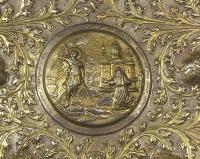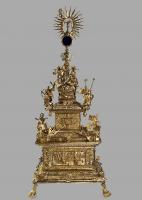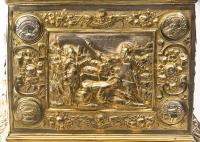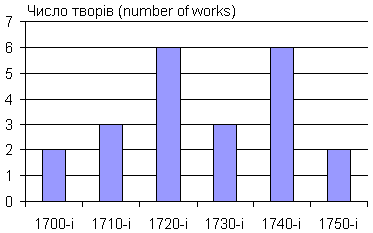Ivan Ravych
Nicholas Zharkikh
Ravych John (1677 – 1762) – famous Kyiv jeweler.
Scientific interest in Ukrainian jewelry began relatively late. After the the collapse of Russian Empire (1917), in connection with the mass confiscation of jewelry values of possession of former ruling circles – the nobility and the church – part of confiscated things came to public museums in Ukraine. Naturally, museums became centers of studying this art.
But after the pioneering works by D.M.Scherbakivsky published in 1920th, in these studies has come a long pause caused by the destruction of scientific Ukrainian studies by criminal communist regime. The next stage – significant publication in 1970 book "Ukrainian jewelry" by M.Z. Petrenko. The book contains a great essay (p. 103 – 116) on life and work of I. Ravych. This publication up today is base on our knowledge of the master.
The next stage of research – articles submitted at the end of 20 – begin of 21 cent. Discovered and put into practice new, previously unknown works of Ravych. However, O. Mishneva suggested that stamp «I.R.», which Petrenko considered as late Ravych's mark, not belong to this master. A special look at Ravych expressed I. T. Chernyakov in the book "" (2008).
What these studies found? First of all, it should be noted that the source base for studies on I. Ravych is extremely poor. Catastrophic fire of Kiev Podil in 1811 completely destroyed the archives of Kiev shops and magistrate, as well as private archives of Podil townspeople. Those sources evidence on Ravych which were collected – are literally crumbs deposited outside Podil. An important source is the jewelry artist's signature.
Father of Ivan Ravych – Andrew Ravych – was a citizen of Kiev (recall that commoners, that is, people owed to the municipal law, only lived at the Podil). What profession was Andrew, who was the mother of Ivan, at what day and month Ivan born – remains unknown.
Ivan Ravych lived at the Podil, in the parish of church st.Nicholas Prytysk. Where there was his estate and that it represented – is unknown. It is known that his wife's name was Maria Vasylivna. She was younger than her husband of 30 years (this can be cautiously assumed that this was the second family of Ivan). This marriage had no children.
What general and professional education received Ravych – is unknown. We know that he knew several foreign languages, signed his works in Latin, which indicates a fairly high level of general education. It is tempting to assume that he studied at the Mohyla College, which was located 500 meters from the st.Nicholas Prytysk church, but there is no documentary confirmed.
M.Z. Petrenko assumed that Ravych acquainted with jewellery in Moscow, St. Petersburg and Germany. But one have remember that these trips were after 1737, when the master was already 60 and more years old and he was long been formed and recognized jeweler. These trips certainly helped to expand his professional horizons, but were not decisive in shaping him as a specialist. (By the way, I can not say on what documents is based Petrenko's allegations that Ravych visiting St. Petersburg, and when it was).
Artistic jewelers environment of Kiev late 17 century, in which, under our assumption, went training Ravych, remains unknown because of lack of documentary materials.
Ivan Ravych as a representative of esteemed career enjoyed considerable authority in the city. It is known that for 30 years he was elected raytsa (coucellor) and lavnyk (judge) of Kyiv city council, that belonged to the main board, which was carried out by urban governments with Magdeburg law. But the specific chronology of his stay in these positions remains unknown.
In 1737 the magistrate sent a complaint addressed to the empress and petition of oppression by the bourgeois members of the Russian administration and the abuses of the cossack officer Chornolutsky. Together with other members of city government a complaint and petition also signed Ivan Ravych.
On the initiative of Ravych Kyiv magistrate, referring to the Magdeburg law, adopted in 1753 a decision not to send students to courses assay masters in Moscow. [Petrenko M.Z. p. 104]
In 1754 lavnyk Ivan Ravych with raytsy Semen Kozelsky and Vasyl Zhuk traveled to Moscow to welcome the newly appointed Kiev vogt Ivan Sichevsky. Members also brought magistrate's request to the Board of Foreign Affairs. In Moscow they were from late March to May [Andryevsky A.A. Ivan Sychevsky vogt of Kiev: 1754 – 1766. – Kievan antiquity, 1891, № 4, p. 3 – 4].
17 Oct 1755 Sychevsky from Petersburg wrote a letter to the Kyiv city council, insisting in particular that lavnyk Ravych came to St. Petersburg to help Sychevsky in his trouble in Kiev cases. But this time the magistrate did not sent deputies [ibid, p. 7].
This is probably all the facts, which are now known about Ravych's participation in the management of Kyiv.
In 1740 I. Ravych traveled to Germany with a rather strange request – to buy books for the Kiev-Pechersk Lavra (since it's library hit hard in the fire in 1718). Ravych visited for the Augsburg and Nuremberg. What books can be purchased there? – Clearly, German and Latin. So Ravych knew these two languages well enough to able to execute such orders. It should be noted that the researchers write about this trip without reference to the source, and it remains poorly studied episode of Ravych's life.
As goldsmith Ravych worked from the first years of 18 century the end of life. There are no specific data about his workshop. Working all time with precious metals, Ravych was not acquired great wealth. When he died (in 1762 – exact date unknown), it appears that he left large debts. The claims to his property declared Kiev-Pechersk Lavra, Sumy regiment judge Alex Savich, cossack officer Andrew Poletyka, priests Jacob Hordynsky (Kobeliaky), Euthimi Bazylevskyi (New Sanzhary), Vasily Lavrynov (Borispol) and others. At the request of creditors, the magistrate described the auction and sold all movable and immovable property of Ravych, which, however, was insufficient to cover all claims [Petrenko M.Z., p. 114]
There are no reliable portrait images of Ravych. In 2008 I. T. Chernyakov in his book "" suggested that Ravych was the author of the Archangel Michael high relief, which was installed on a pediment of St. Michael's Golden-Domed Cathedral, and that mascarons on the right shoulder of angel is master's self-portrait:
Among the artists works in Kyiv on the metal art of this period, our attention was attracted by the famous and talented master Ivan A. Ravych (1677 – 1762's). It is not just that the years of his work coincide with a possible period of production of copper high relief, and that his manner of creative use of vegetable ornamentation, many developing image of Archangel Michael in different jobs point to a possibility of membership and the work to metal plastic heritage of most popular Ukrainian jewelers.
Such arguments as the similarity of iconography, or the way of treatment plants, or divided forms of high relief (which indicates, according Chernyakov, that had master was miniaturist–jeweler, not a monumentalist) is certainly not sufficient to claim that the high relief fulfilled by jeweler, and especially do not give specific data on the person. In addition, we have no documentary data to consider Ravych involved in sculpture. Finally, Chernyakov himself said:
Our observations concerning the possibility of master self-portrait in the mascaron's image on the right shoulder of Michael high relief is still a hypothesis, as yet not found any documents about its creation.
More than 70 jewelry works by I. Ravych preserved to our time. This includes works with «I.R.» mark, which belongs to I. Ravych is doubtful in today's researchers. Undisputed I. Ravych's works now know 17. The following is a list of dated works:
Late 1917 – early 18 century. Silver mug for Hetman Ivan Mazepa (Chernigov State Historical Museum, № 3424) [Petrenko M.Z., p. 105]. On what basis the original date of product considered end 17 century – unknown, end date, not later which mug should be made, considered in 1708 – the last year, when Mazeppa was in Ukraine.
1703 Silver mount on the Gospel (Kyiv State Historical Museum, № 1514) [Petrenko M.Z., p. 106].
Around 1715 Gilded silver kettle with arms of Pereyaslav colonel S. Tomara (Reserve «Kiev–Pechersk Lavra», № 2203) [Petrenko M.Z., p. 105].
1717 Gilded silver setting of the Gospel (Kyiv State Historical Museum, № 4363; now – Museum of Historical Treasures of Ukraine, № 4363 – DM) for Vydubytsky Kiev monastery, ordered by its Abbot Lawrence Gorka [Petrenko M.Z., p. 179].
1720 Gilded silver cup for consecration of water (State Museum of Ukrainian Art, № 218) for Kiev Saint Sophia Cathedral [Petrenko M.Z., p. 180].
March 1, 1721 Candlesticks (Kyiv State Historical Museum, № 4784, 4785) for the Dormition Cathedral of Kyiv Pechersk Lavra ordered by novice Gordian [Petrenko M.Z., p. 179].
April 20, 1721 Gilded silver setting of the Gospel (Kharkiv Art Museum, № 5269) for the Lubny Mgar monastery [Petrenko M.Z., p. 178 – 179].
September 1721 Candlesticks (deposit inscription mentions them in the plural, but only one preserved – Kyiv State Historical Museum, № 5498) for Vydubytsky Kiev monastery, ordered by its governor Vasily [Petrenko M.Z., p. 179].
1722 Cruet (Kyiv State Historical Museum, № 310) for the Annunciation Church in the village Ostapivka [Petrenko M.Z., p. 178].

|

|
| Gilded silver dish Vydubytsky Kiev Monastery, 1723 | Miracle at Honah. Central part of the dish 1723 |
Master introduces an architectural monument in composition – St. George's Cathedral of Monastery shown against Dnipro hills. Ivan Ravych tied known event to a specific area, thus combining the real and unreal, that was a feature for Baroque [Museum of Historical Treasures of Ukraine: guide–directory].
In fact, at the right of the composition shown three-part church, whose altar and vestibule have radial plan. The church has three round domes and a flashlight. In the domes cut window.
Kiev architecture then gives a few examples of rounded volumes (altar of the church of the Exaltation at the Near Caves), but were always cutted domes that is characteristic feature of Ukrainian architecture of the time. Round domes are very characteristic of Russian architecture 16 – 17 centuries.
The image have nothing common with the real St. George's Cathedral, which has five cutted volumes and cutted domes. This picture is a generalized image of the Orthodox Church at that time.
1723 Gilded silver dish (Kyiv State Historical Museum, № 4599; now – Museum of Historical Treasures of Ukraine, № 4599 – DM) for Vydubytsky Kiev monastery, ordered by abbot Theodosius Khomenko [Petrenko M.Z., p. 180].
1724 Setting on the icon of the Virgin Hoderetria (State Museum of Ukrainian Art, № 213) [Petrenko M.Z., p. 179].
1731 Cruet (Kyiv State Historical Museum, № 1607) for the Christmas Church in Kiev, ordered by Kiev citizen Gabriel Trokhymovych [Petrenko M.Z., p. 178].
1738 Cruet (Kyiv State Historical Museum, № 436) for the st.Michael's church in Glukhiv, ordered by captain's widow Kryska Nikiforovna [Petrenko M.Z., p. 178].
1738 Silver altar cross (Reserve «Kiev–Pechersk Lavra», № KPL – M- 9419) for "monastery of st. Trinity […] Krasnogorsky" [Bolharova M.U., Shelapov S.M.].

|

|
| Pyx of Kyiv Pechersk Lavra, 1743 | Carrying the Cross. Fragment of pyx 1743 |
1743 Pyx (Reserve «Kiev–Pechersk Lavra», № 2896; now – Museum of Historical Treasures of Ukraine, № 7903 – DM) for the Kiev-Pechersk Lavra, ordered the Abbess Helena (Baroness Descantin) [Petrenko M.Z., p. 179 – 180].
February 1747 Candlesticks (Reserve «Kiev–Pechersk Lavra», № 1626, 1627) for the house of the Kiev Academy, ordered by its prefect Barlaam Laschevsky [Petrenko M.Z., p. 179].
1747 Ravych altered setting of the Gospel, made in 1695 for the Kiev- Pechersk Lavra (Reserve «Kiev–Pechersk Lavra», № 415) [Petrenko M.Z., p. 178].
1747..1757 Silver cap (Chernigov State Historical Museum, № 3620) with the arms of Metropolitan Timothy Scherbatsky and Ravych's stamp [Petrenko M.Z., p. 107]. Dated by the time Scherbatsky stay in office.
November 6, 1749 Two silver cruets (Reserve «Kiev–Pechersk Lavra», № 1122, 2249) for Glukhiv st.Peter and Paul Monastery, ordered by its Archimandrite Nicephorus Gribovsky [Petrenko M.Z., p. 178].
1749 Cruet (Poltava Art Museum, № 2253) for st.John the Baptist church in the village Mylyutyntsi ordered by local Mr. Fedor Tikhonovich [Petrenko M.Z., p. 178].
1750..1762 Three silver caps (State Historical Museum (Moscow), № 691sch, 23510sch; Armory (Moscow), № 15 640) with Ravych's stamp and arms Hetman K. Razumovsky [Petrenko M.Z., p. 107]. Date from the time of appointment Razumovsky Hetman (1750) to the master's death (1762)
1760 Silver cruet (Reserve «Kiev–Pechersk Lavra», № 746) [Petrenko M.Z., p. 111].

Chart of Ravych's activity
Ravych getting Started jewelers in the first years of 18 century. One of his first customers was a hetman Ivan Mazepa, for whom Ravych prepared silver mug. So we can assume that the old hetman was personally acquainted with quite young then master.
But it should be noted: when rised the issue of production silver Royal Gates for st.Boris and Gleb Cathedral in Chernigov, I. Mazepa ordered them (1701) Augsburg master Jacob Drenvetti. Thus, the most extensive jewelry of Ivan Mazepa's days "slipped" from the hands of Kyiv jewelers. Maybe Mazeppa was not sure of their creative and production capabilities. It is also possible that the mug was ordered to Ravych after 1701.
There is mention that Ravych worked to the order of Hetman I. Skoropadsky, but this product(s?) are not described in detail [Bonkovska S., p. 166].
Activity diagram shows that the most fruitful for Ravych were 1720 – 40th years – 70% of its dated products falls to this time.
Among those signed Ravych works – a set of silver cups for Hetman K. Razumovsky, from which preserved three items. These two orders of hetmans formed like a frame in which locked Ravych's jewelry creativity. Area of existence of his pieces was Hetmanate (to Russia some of its products fell during the later motion of values) and range of customers – Cossack officers and Orthodox Church.
It was a period of political stability of Hetmanate, when came to power (and therefore began to be enriched) Orthodox Cossack officers. They expressed their devotion in generous gifts in favor of the Orthodox Church, which notably included large amount of precious metals. Orthodox church, enjoying the protection and support of the government, not afraid to accumulate these treasures and openly proud of them.
Thus, the conditions for jewelry were favorable. Ivan Ravych take advantage of these conditions and reforge a lot of precious metal to works of art, whose value is much higher than the the cost of the metal from which they are made. His creativity in general embedded in the later stage of the Ukrainian baroque when demand of external splendor (sometimes even excessive) was in the foreground.
This external splendor corrsponds to the jewelry very well. Products by Ravych contain many small and smallest details, each of which performed extremely carefully and accurately. Every free plane he filled with ornament or relief background, trying to get rid of large smooth surfaces. This was "jewelry" in the full sense of the expression, when every detail can be seen as a particular artwork.
It is noticeable that the development of Orthodox art in the direction of more and more pomp repeating the same line of the Catholic Counter-Reformation art, including borrowing Baroque forms (and sometimes not alone forms, but also iconography, scenes, ideas and representations) seem natural.
However, one should note that religiosity, which is expressed only in the external, visual splendor, has been very one-sided. Church get accustomed to live in an environment of gold and silver items, lost its spiritual essence and transformed to the banker, the storehouse of wealth. And what it would do (and will do), when the revolution comes? But Ivan Ravych was not guilty in this transformation of the church…
Further studies of the I. Ravych in my opinion should include:
- assembly text of all written documentary sources on Ravych;
- compilation of a scientific catalog of his works, including dubia;
- resolving contentious issues of attribution of his works, establishment of their chronology;
- comparative studies of Ravych's works of contemporary and earlier works of Jewelers of Ukraine and Europe.
On this basis, one can write a monograph on Ravych (which he certainly deserves) and to clarify its place in the development of Ukrainian art and its influence on the further development of goldsmithing.
I express gratitude to Dmitri Vortman (Institute of History of Ukraine) and George Bilan (Museum of Historical Treasures of Ukraine), who gave me material for this article.
Literature
Petrenko M.Z. Ukrainian jewelry 16 – 18 centuries. – K.: Naukova Dumka, 1970, p. 103 – 116, 178 – 180.
Mishneva O.I. Ivan Ravych – prominent Ukrainian jeweller of the Baroque // Lavra Almanac. – Vol. 3. – K., 2001. – S. 124-130.
Bonkovska S. Church art metal. – History of Decorative Arts of Ukraine. T. 2. Art XVII-XVIII centuries. K., 2007, p. 166 – 168.
Museum of Historical Treasures of Ukraine: guide-catalog. – K.: 2008 [e–publication on CD–ROM].
Chernyakov I.T. . – K.: Myslene drevo, 2008 [e–publication on CD-ROM].
Bolharova M.U., Shelapov S.M. Altar cross of I. Ravych from the collection of the National Kyiv-Pechersk Historical and cultural reserve. // Mogila's reading 2008, K., 2009, p. 466-472.
Kyiv, Aug 8, 2012.
